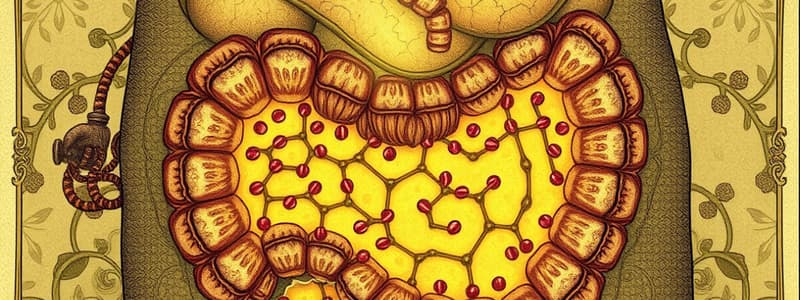Podcast
Questions and Answers
Which molecules are produced from the digestion of fats?
Which molecules are produced from the digestion of fats?
- Glycerol and fatty acids (correct)
- Monosaccharides
- Polysaccharides
- Amino acids
Some food molecules do not require digestion.
Some food molecules do not require digestion.
True (A)
What are indigestible fibers that humans cannot break down?
What are indigestible fibers that humans cannot break down?
Cellulose
What is the role of fiber in a balanced diet?
What is the role of fiber in a balanced diet?
The three stages of digestion are digestion, degradation, and complete oxidation to _____, _____, and energy.
The three stages of digestion are digestion, degradation, and complete oxidation to _____, _____, and energy.
What does ATP stand for?
What does ATP stand for?
Hydrolysis of two phosphate groups from ATP releases more energy than hydrolysis of one phosphate group.
Hydrolysis of two phosphate groups from ATP releases more energy than hydrolysis of one phosphate group.
What is the process that regenerates ATP in the body?
What is the process that regenerates ATP in the body?
Energy + 6 H2O + 6 CO2 → _____ + 6 O2 represents the process of _____
Energy + 6 H2O + 6 CO2 → _____ + 6 O2 represents the process of _____
Match the following terms related to metabolism with their descriptions:
Match the following terms related to metabolism with their descriptions:
Flashcards are hidden until you start studying
Study Notes
Digestion Overview
- Digestion breaks down food into simpler molecules for absorption into the bloodstream.
- Involves hydrolases that catalyze the hydrolysis of food components:
- Polysaccharides and disaccharides are converted to monosaccharides.
- Fats are broken down into glycerol and fatty acids.
- Proteins are decomposed into amino acids.
Absorption of Nutrients
- Some substances do not require digestion and can be directly absorbed, including:
- Monosaccharides
- Inorganic salts
- Vitamins
- These nutrients, being in their simplest form, easily cross cell membranes.
- Indigestible substances, such as cellulose, cannot be absorbed.
Role of Fiber
- Fiber is crucial for a healthy diet and helps prevent:
- Heart disease
- Diabetes
- Weight gain
- Certain cancers
- It aids in lowering cholesterol levels and promoting digestive health.
Stages of Digestion
- Stage 1: Digestion occurs in:
- Mouth
- Stomach
- Small intestine
- Bulk food is broken down into small molecules.
- Stage 2: Degradation and Oxidation involves:
- Degradation of sugars, fatty acids, and amino acids to smaller molecules (mostly acetyl-CoA) in the cytoplasm.
- Stage 3: Complete Oxidation produces CO2, H2O, and energy for ATP production.
Metabolism
- Describes all chemical reactions that supply energy and materials for cell growth.
- Catabolism: Breaks down complex molecules, releasing energy.
- Anabolism: Builds large molecules from simpler ones using available energy.
Carbohydrate Origin
- Carbohydrates are produced during photosynthesis:
- Formula: Energy + 6 H2O + 6 CO2 → C6H12O6 + 6 O2
ATP and Energy
- ATP (adenosine triphosphate) is the primary high-energy molecule in cells, composed of:
- Adenine
- Ribose
- Three phosphate groups
- Hydrolysis of one phosphate group releases energy of 7.3 kcal/mol (31 kJ/mol).
- Hydrolysis of two phosphate groups releases energy of 7.7 kcal/mol (31 kJ/mol).
- ATP drives energy-requiring reactions that cannot occur independently.
- The body's ATP supply is limited; ATP is regenerated via phosphorylation.
Studying That Suits You
Use AI to generate personalized quizzes and flashcards to suit your learning preferences.




